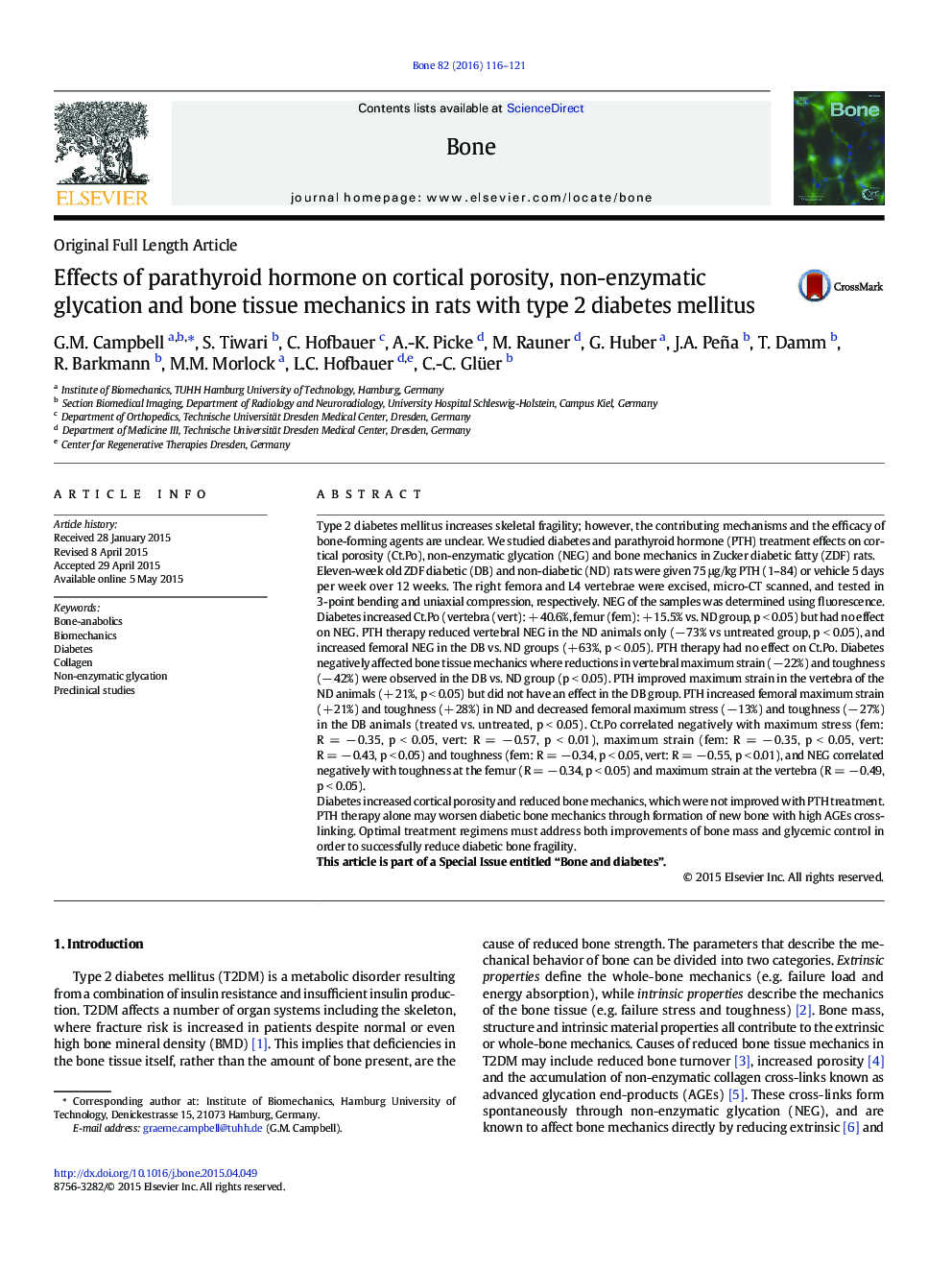| کد مقاله | کد نشریه | سال انتشار | مقاله انگلیسی | نسخه تمام متن |
|---|---|---|---|---|
| 5889103 | 1568137 | 2016 | 6 صفحه PDF | دانلود رایگان |
- We study the effect of diabetes and PTH on bone mechanics, porosity and NEG in rats.
- Diabetes reduced bone tissue mechanics and increased porosity.
- PTH improved mechanics and NEG in non-diabetic but not diabetic animals.
- PTH plus glycemic controlling agents may be required to strengthen diabetic bone.
Type 2 diabetes mellitus increases skeletal fragility; however, the contributing mechanisms and the efficacy of bone-forming agents are unclear. We studied diabetes and parathyroid hormone (PTH) treatment effects on cortical porosity (Ct.Po), non-enzymatic glycation (NEG) and bone mechanics in Zucker diabetic fatty (ZDF) rats.Eleven-week old ZDF diabetic (DB) and non-diabetic (ND) rats were given 75 μg/kg PTH (1-84) or vehicle 5 days per week over 12 weeks. The right femora and L4 vertebrae were excised, micro-CT scanned, and tested in 3-point bending and uniaxial compression, respectively. NEG of the samples was determined using fluorescence.Diabetes increased Ct.Po (vertebra (vert): + 40.6%, femur (fem): + 15.5% vs. ND group, p < 0.05) but had no effect on NEG. PTH therapy reduced vertebral NEG in the ND animals only (â 73% vs untreated group, p < 0.05), and increased femoral NEG in the DB vs. ND groups (+ 63%, p < 0.05). PTH therapy had no effect on Ct.Po. Diabetes negatively affected bone tissue mechanics where reductions in vertebral maximum strain (â 22%) and toughness (â 42%) were observed in the DB vs. ND group (p < 0.05). PTH improved maximum strain in the vertebra of the ND animals (+ 21%, p < 0.05) but did not have an effect in the DB group. PTH increased femoral maximum strain (+ 21%) and toughness (+ 28%) in ND and decreased femoral maximum stress (â 13%) and toughness (â 27%) in the DB animals (treated vs. untreated, p < 0.05). Ct.Po correlated negatively with maximum stress (fem: R = â 0.35, p < 0.05, vert: R = â 0.57, p < 0.01), maximum strain (fem: R = â 0.35, p < 0.05, vert: R = â 0.43, p < 0.05) and toughness (fem: R = â 0.34, p < 0.05, vert: R = â 0.55, p < 0.01), and NEG correlated negatively with toughness at the femur (R = â 0.34, p < 0.05) and maximum strain at the vertebra (R = â 0.49, p < 0.05).Diabetes increased cortical porosity and reduced bone mechanics, which were not improved with PTH treatment. PTH therapy alone may worsen diabetic bone mechanics through formation of new bone with high AGEs cross-linking. Optimal treatment regimens must address both improvements of bone mass and glycemic control in order to successfully reduce diabetic bone fragility.This article is part of a Special Issue entitled “Bone and diabetes”.
Journal: Bone - Volume 82, January 2016, Pages 116-121
